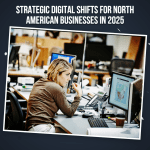Executive Summary
Small and mid-sized enterprises now face a data deluge that was once the sole domain of large corporations. Transaction volumes spike in real time, supply chains fluctuate with geopolitical news, and investor sentiment shifts overnight. Traditional finance departments, reliant on quarterly forecasts and manual reconciliations, struggle to keep pace. Agentic artificial intelligence is emerging as the disciplined digital deputy every chief financial officer needs. Unlike conventional automation that follows rigid scripts, agentic AI observes financial signals, reasons through scenarios, and recommends or executes actions that protect cash flow and advance strategic goals.
Defining Agentic AI in Financial Context
Agentic AI refers to software agents endowed with three core attributes: autonomous planning, contextual reasoning, and continuous learning. These systems ingest structured data from enterprise resource planning tools, semi-structured feeds from sales or inventory platforms, and even unstructured information such as macroeconomic alerts. They then synthesize insights without waiting for explicit queries.
- Autonomous Planning
The agent sets goals such as reducing accounts receivable days or optimizing working capital cycles. It proposes stepwise tasks—issuing early-payment incentives, renegotiating vendor terms, or throttling discretionary spend—to realize those goals. - Contextual Reasoning
When an unexpected dip in revenue coincides with a foreign-exchange swing, the agent correlates the two and suggests hedging instruments. This reasoning capability surpasses static dashboards that isolate variables. - Continuous Learning
Each transaction, policy adjustment, or market shock refines the model’s predictive accuracy. Over time, the agent evolves from descriptive reporting to prescriptive guidance.
Key Capabilities That Reshape the Finance Function
Real-Time Cash Flow Surveillance
Agentic AI connects directly to bank feeds and invoicing systems, parsing inflows and outflows minute by minute. It flags anomalies such as a sudden concentration of late payments or an unexpected spike in freight costs. Early detection allows finance leaders to secure short-term credit facilities or adjust procurement schedules before liquidity erodes.
Dynamic Scenario Forecasting
Traditional budgeting often relies on quarterly snapshots. Agentic AI maintains rolling twelve-month forecasts that update whenever sales pipelines shift or operating expenses tilt. The system models best-case, base-case, and worst-case trajectories, equipping CFOs to recalibrate hiring plans and capital expenditures with confidence.
Automated Compliance and Audit Trails
Regulatory complexity intensifies annually. Intelligent agents cross-reference ledger entries against tax codes, industry guidelines, and internal approval matrices. Each automated decision is timestamped and traced, producing auditable evidence that reduces the cost and duration of external reviews.
Accelerated Close and Consolidation
Month-end close traditionally demands manual reconciliations across subsidiaries. Agentic AI standardizes chart-of-accounts mappings, reconciles intercompany eliminations, and surfaces discrepancies for swift resolution. The accelerated close frees finance teams to focus on value-added analysis rather than rote consolidation.
Strategic Advantages for Small and Mid-Sized Enterprises
- Operational Efficiency
By automating ledger maintenance, expense classification, and variance checks, the finance team shifts from data entry to strategic advisory functions. - Enhanced Decision Velocity
Real-time insights allow leadership to seize fleeting market opportunities, whether that means opportunistic inventory purchases or rapid price adjustments. - Risk Mitigation
Continuous monitoring of payment behavior and supplier health mitigates counterparty risk, while predictive alerts reduce the probability of covenant breaches. - Capital Optimization
Agentic AI evaluates financing options—short-term debt, equipment leasing, or equity infusion—against projected cash flows, enabling cost-effective capital allocation.
Implementation Roadmap: From Pilot to Enterprise-Wide Deployment
Step 1: Data Foundation
Begin with a systematic inventory of financial systems—general ledger, accounts payable, receivable, payroll, and treasury. Ensure clean, normalized data feeds via application programming interfaces or extract-transform-load workflows. Data integrity is non-negotiable; poor inputs erode model reliability.
Step 2: Policy Configuration
Define guardrails that reflect risk appetite and governance standards. Set approval thresholds for automated payments, specify escalation paths for exceptions, and codify compliance requirements. These rules ensure autonomy aligns with fiduciary duty.
Step 3: Pilot Use Case Selection
Select a narrowly scoped yet high-impact process, such as automated dunning or dynamic cash-position forecasting. Establish baseline metrics—days sales outstanding, close cycle duration, or forecast variance—so that pilot benefits are quantifiable.
Step 4: Performance Review and Iteration
After a predefined period, compare pilot outcomes to baselines. Refine algorithms, expand data sources, and incorporate user feedback. Once benchmarks show sustained improvement, scale the agent to adjacent workflows.
Governance, Ethics, and Risk Considerations
Agentic AI introduces new dimensions of operational risk that require board-level oversight.
- Model Drift and Bias
Economic regimes shift, and historical data may skew predictions. Regular model validation and retraining protect against drift. - Data Security
Financial information is a prime target for cybercriminals. Encryption, intrusion detection, and rigorous access controls remain essential. - Human Oversight
Autonomous agents suggest, but CFOs approve. Clear roles and responsibilities prevent blind trust in algorithmic outputs. - Vendor Lock-In
Favor platforms that support open standards and data portability to maintain strategic flexibility.
Case Illustration: Manufacturing Firm Reduces Days Sales Outstanding
A mid-market manufacturer with annual revenue of twenty million dollars piloted agentic AI to address chronic cash constraints. The agent integrated with the firm’s enterprise resource planning system and customer relationship management platform. Within two weeks, it identified a subset of high-value customers with consistent late payments. The system crafted individualized early-payment incentives and dunning schedules. Over three months, days sales outstanding dropped from fifty-two to thirty-seven, releasing four hundred thousand dollars in working capital without additional headcount.
Future Outlook: The CFO’s Evolving Role
By 2027, leading analysts forecast that autonomous agents will handle upward of sixty percent of routine finance tasks in high-performing small enterprises. As repetitive work recedes, CFOs will shift toward strategic leadership, spearheading mergers, sustainability initiatives, and data-driven growth programs. Agentic AI will not replace the finance executive; it will amplify the executive’s ability to steer the organization through volatility.
Conclusion
Agentic AI stands poised to redefine finance in small and mid-sized enterprises. Through autonomous planning, contextual reasoning, and continuous learning, these digital deputies deliver real-time insights, automate compliance, and unlock working capital. Adoption requires disciplined data management, robust governance, and incremental scaling. Firms that invest today will not only streamline operations but also position themselves for resilient growth in a business environment defined by speed, complexity, and opportunity.









